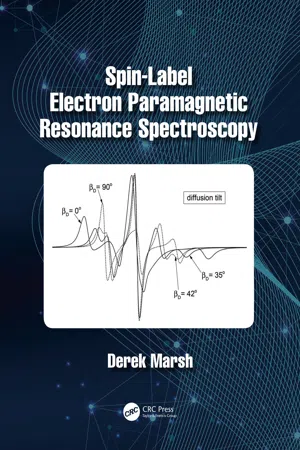
- 472 pages
- English
- ePUB (mobile friendly)
- Available on iOS & Android
Spin-Label Electron Paramagnetic Resonance Spectroscopy
About this book
Spin-label electron paramagnetic resonance (EPR) spectroscopy is a versatile molecular probe method that finds wide application in molecular biophysics and structural biology. This book provides the first comprehensive summary of basic principles, spectroscopic properties, and use for studying biological membranes, protein folding, supramolecular structure, lipid-protein interactions, and dynamics. The contents begin with discussion of fundamental theory and practice, including static spectral parameters and conventional continuous-wave (CW) spectroscopy. The development then progresses, via nonlinear CW-EPR for slower motions, to the more demanding time-resolved pulse EPR, and includes an in-depth treatment of spin relaxation and spectral line shapes. Once the spectroscopic fundamentals are established, the final chapters acquire a more applied character. Extensive appendices at the end of the book provide detailed summaries of key concepts in magnetic resonance and chemical physics for the student reader and experienced practitioner alike.
Key Features:
Indispensable reference source for the understanding and interpretation of spin-label spectroscopic data in its different aspects. Tables of fundamental spectral parameters are included throughout.
The primary audience is research workers in the fields of molecular biophysics, structural biology, biophysical chemistry, physical biochemistry and molecular biomedicine. Also, physical chemists, polymer physicists, and liquid-crystal researchers will benefit from this book, although illustrative examples used are often taken from the biomolecular field. Readers will be postgraduate researchers and above, but include those from other disciplines who seek to understand the primary spin-label EPR literature.
Frequently asked questions
- Essential is ideal for learners and professionals who enjoy exploring a wide range of subjects. Access the Essential Library with 800,000+ trusted titles and best-sellers across business, personal growth, and the humanities. Includes unlimited reading time and Standard Read Aloud voice.
- Complete: Perfect for advanced learners and researchers needing full, unrestricted access. Unlock 1.4M+ books across hundreds of subjects, including academic and specialized titles. The Complete Plan also includes advanced features like Premium Read Aloud and Research Assistant.
Please note we cannot support devices running on iOS 13 and Android 7 or earlier. Learn more about using the app.
Information
1
Introduction
1.1 Introduction



Table of contents
- Cover
- Half Title
- Title Page
- Copyright Page
- Dedication Page
- Table of Contents
- Preface
- Author
- 1 Introduction
- 2 The Nitroxide EPR Spectrum
- 3 Hyperfine Interactions and g-Values
- 4 Polarity Dependence
- 5 Spin Relaxation Theory
- 6 EPR Lineshape Theory
- 7 Dynamics and Rotational Diffusion
- 8 Dynamics and Orientational Ordering (Liquid Crystals and Membranes)
- 9 Spin–Spin Interactions
- 10 Spin–Lattice Relaxation
- 11 Nonlinear and Saturation-Transfer EPR
- 12 Saturation-Recovery EPR and ELDOR
- 13 Spin-Echo EPR
- 14 ESEEM and ENDOR: Hyperfine Spectroscopy
- 15 Distance Measurements
- 16 Site-Directed Spin Labelling (SDSL)
- Fundamental Physical Constants
- Appendices A–M: Fundamentals
- Appendices N–V: Specialist Topics
- Index